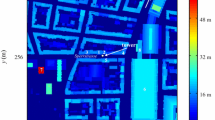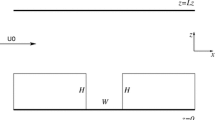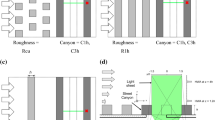Abstract
Atmospheric flow and temperature dynamics in the urban roughness sublayer exhibit numerous complexities that cannot all be investigated using models or scaled-down experiments, thus these complexities necessitate careful field observations. Such dynamics were studied under a comprehensive set of wind directions, wind speeds, and thermal stability conditions in a field campaign held in Guelph, Ontario, Canada, from 13th to 25th of August 2017. The urban site was a quasi-two-dimensional canyon with unit canyon aspect ratio. Beside characterizing thermal stability, inertial effects, urban heat island intensity, and mean properties of the atmosphere, the turbulence statistics were studied carefully as functions of roof-level wind angle, diurnal time, the building Reynolds number, or the bulk Richardson number. Turbulence statistics in the vertical direction were observed to be influenced by local conditions, such as flow properties and nearby surface temperatures. These statistics also indicated presence of small integral lengthscales and short integral timescales. On the other hand, turbulence statistics in the horizontal directions were influenced by non-local conditions, such as horizontal heterogeneity in heating or urban morphology. These statistics indicated presence of large integral lengthscales and long integral timescales. In addition, a rigorous scaling analysis was performed to seek significant correlations between turbulence statistics and other known flow variables both locally or as measured at a nearby non-urban rural station. Variances scaled more successfully to mean quantities than covariances (Reynolds stresses and turbulence kinematic heat fluxes). In addition, the statistics in the vertical direction scaled more successfully compared to horizontal directions. Statistics in the horizontal directions, particularly in the along-canyon axis direction, were poorly scaled, suggesting presence of unorganized and irregular turbulence structures influenced by non-local conditions. Temperature difference between the atmosphere and nearby surfaces as well as measured velocity scales showed to scale vertical heat fluxes successfully.

















Similar content being viewed by others
References
Aliabadi AA (2018) Theory and applications of turbulence: a fundamental approach for scientists and engineers. Amir A. Aliabadi Publications, Guelph, ON
Aliabadi AA, Staebler RM, Liu M, Herber A (2016) Characterization and parametrization of Reynolds stress and turbulent heat flux in the stably-stratified lower Arctic troposphere using aircraft measurements. Boundary-Layer Meteorol 161(1):99–126
Aliabadi AA, Krayenhoff ES, Nazarian N, Chew LW, Armstrong PR, Afshari A, Norford LK (2017) Effects of roof edge roughness on air temperature and pollutant concentration in urban canyons. Boundary-Layer Meteorol 164(2):249–279
Arnfield AJ (2003) Two decades of urban climate research: a review of turbulence, exchanges of energy and water, and the urban heat island. Int J Climatol 23(1):1–26
Balogun AA, Tomlin AS, Wood CR, Barlow JF, Belcher SE, Smalley RJ, Lingard JJN, Arnold SJ, Dobre A, Robins AG, Martin D, Shallcross DW (2010) In-street wind direction variability in the vicinity of a busy intersection in central London. Boundary-Layer Meteorol 136(3):489–513
Barlow JF, Halios CH, Lane SE, Wood CR (2015) Observations of urban boundary layer structure during a strong urban heat island event. Environ Fluid Mech 15(2):373–398
Blackman K, Perret L, Savory E, Piquet T (2015) Field and wind tunnel modeling of an idealized street canyon flow. Atmos Environ 106:139–153
Cheng WC, Porté-Agel F (2015) Adjustment of turbulent boundary-layer flow to idealized urban surfaces: a large-eddy simulation study. Boundary-Layer Meteorol 155(2):249–270
Chew LW, Nazarian N, Norford L (2017) Pedestrian-level urban wind flow enhancement with wind catchers. Atmosphere (Basel) 8(159):1–22
Coutts AM, White EC, Tapper NJ, Beringer J, Livesley SJ (2016) Temperature and human thermal comfort effects of street trees across three contrasting street canyon environments. Theor Appl Climatol 124(1):55–68
Eliasson I, Offerle B, Grimmond CSB, Lindqvist S (2006) Wind fields and turbulence statistics in an urban street canyon. Atmos Environ 40(1):1–16
Giometto MG, Christen A, Meneveau C, Fang J, Krafczyk M, Parlange MB (2016) Spatial characteristics of roughness sublayer mean flow and turbulence over a realistic urban surface. Boundary-Layer Meteorol 160(3):425–452
Girard P (2016) Validation partielle et développement d’un modèle de microclimat urbain. Master’s thesis, Laval University
Graf A, van de Boer A, Moene A, Vereecken H (2014) Intercomparison of methods for the simultaneous estimation of zero-plane displacement and aerodynamic roughness length from single-level eddy-covariance data. Boundary-Layer Meteorol 151(2):373–387
Hu XM, Xue M, Klein PM, Illston BG, Chen S (2016) Analysis of urban effects in Oklahoma city using a dense surface observing network. J Appl Meteorol Clim 55(3):723–741
Inagaki A, Kanda M (2008) Turbulent flow similarity over an array of cubes in near-neutrally stratified atmospheric flow. J Fluid Mech 615:101–120
Inagaki A, Kanda M (2010) Organized structure of active turbulence over an array of cubes within the logarithmic layer of atmospheric flow. Boundary-Layer Meteorol 135(2):209–228
Jamei E, Rajagopalan P, Seyedmahmoudian M, Jamei Y (2016) Review on the impact of urban geometry and pedestrian level greening on outdoor thermal comfort. Renew Sust Energ Rev 54:1002–1017
Kastner-Klein P, Berkowicz R, Britter R (2004) The influence of street architecture on flow and dispersion in street canyons. Meteorol Atmos Phys 87(1):121–131
Kellnerová R, Kukačka L, Jurčáková K, Uruba V, Jaňour Z (2012) PIV measurement of turbulent flow within a street canyon: detection of coherent motion. J Wind Eng Ind Aerodyn 104–106:302–313
Klein P, Clark JV (2007) Flow variability in a North American downtown street canyon. J Appl Meteorol Clim 46:851–877
Klein PM, Galvez JM (2015) Flow and turbulence characteristics in a suburban street canyon. Environ Fluid Mech 15(2):419–438
Krayenhoff ES, Voogt JA (2007) A microscale three-dimensional urban energy balance model for studying surface temperatures. Boundary-Layer Meteorol 123(3):433–461
Krayenhoff ES, Voogt JA (2010) Impacts of urban albedo increase on local air temperature at daily-annual time scales: model results and synthesis of previous work. J Appl Meteorol Clim 49:1634–1648
Krayenhoff ES, Santiago JL, Martilli A, Christen A, Oke TR (2015) Parametrization of drag and turbulence for urban neighbourhoods with trees. Boundary-Layer Meteorol 156(2):157–189
Li XX, Britter RE, Koh TY, Norford LK, Liu CH, Entekhabi D, Leung DYC (2010) Large-eddy simulation of flow and pollutant transport in urban street canyons with ground heating. Boundary-Layer Meteorol 137(2):187–204
Li XX, Britter RE, Norford LK (2015) Transport processes in and above two-dimensional urban street canyons under different stratification conditions: results from numerical simulation. Environ Fluid Mech 15(2):399–417
Louka P, Belcher SE, Harrison RG (2000) Coupling between air flow in streets and the well-developed boundary layer aloft. Atmos Environ 34(16):2613–2621
Nakamura Y, Oke TR (1988) Wind, temperature and stability conditions in an east–west oriented urban canyon. Atmos Environ 22(12):2691–2700
Nazarian N, Kleissl J (2016) Realistic solar heating in urban areas: air exchange and street-canyon ventilation. Build Environ 95:75–93
Nazarian N, Martilli A, Kleissl J (2018) Impacts of realistic urban heating, part I: spatial variability of mean flow, turbulent exchange and pollutant dispersion. Boundary-Layer Meteorol 166(3):367–393
Nelson MA, Pardyjak ER, Brown MJ, Klewicki JC (2007) Properties of the wind field within the Oklahoma City Park Avenue street canyon. Part II: spectra, cospectra, and quadrant analyses. J Appl Meteorol Clim 46(12):2055–2073
Nelson MA, Pardyjak ER, Klewicki JC, Pol SU, Brown MJ (2007) Properties of the wind field within the Oklahoma City Park Avenue street canyon. Part I: mean flow and turbulence statistics. J Appl Meteorol Clim 46(12):2038–2054
Offerle B, Eliasson I, Grimmond CSB, Holmer B (2007) Surface heating in relation to air temperature, wind and turbulence in an urban street canyon. Boundary-Layer Meteorol 122(2):273–292
Ohya Y (2001) Wind-tunnel study of atmospheric stable boundary layers over a rough surface. Boundary-Layer Meteorol 98(1):57–82
Oke TR (1988) Street design and urban canopy layer climate. Energy Build 11(1):103–113
Patton EG, Sullivan PP, Shaw RH, Finnigan JJ, Weil JC (2016) Atmospheric stability influences on coupled boundary layer and canopy turbulence. J Atmos Sci 73(4):1621–1647
Ramamurthy P, Pardyjak ER, Klewicki JC (2007) Observations of the effects of atmospheric stability on turbulence statistics deep within an urban street canyon. J Appl Meteorol Clim 46(12):2074–2085
Raupach MR, Thom AS, Edwards I (1980) A wind-tunnel study of turbulent flow close to regularly arrayed rough surfaces. Boundary-Layer Meteorol 18(4):373–397
Rotach MW, Vogt R, Bernhofer C, Batchvarova E, Christen A, Clappier A, Feddersen B, Gryning SE, Martucci G, Mayer H, Mitev V, Oke TR, Parlow E, Richner H, Roth M, Roulet YA, Ruffieux D, Salmond JA, Schatzmann M, Voogt JA (2005) BUBBLE-an urban boundary layer meteorology project. Theor Appl Climatol 81(3):231–261
Saathoff P, Gupta A, Stathopoulos T, Lazure L (2009) Contamination of fresh air intakes due to downwash from a rooftop structure. J Air Waste Manage Assoc 59(3):343–353
Santamouris M (ed) (2006) Environmental design of urban buildings: an integrated approach. Earthscan, London
Santamouris M, Papanikolaou N, Koronakis I, Livada I, Asimakopoulos D (1999) Thermal and air flow characteristics in a deep pedestrian canyon under hot weather conditions. Atmos Environ 33(27):4503–4521
Savory E, Perret L, Rivet C (2013) Modelling considerations for examining the mean and unsteady flow in a simple urban-type street canyon. Meteorol Atmos Phys 121(1):1–16
Takimoto H, Sato A, Barlow JF, Moriwaki R, Inagaki A, Onomura S, Kanda M (2011) Particle image velocimetry measurements of turbulent flow within outdoor and indoor urban scale models and flushing motions in urban canopy layers. Boundary-Layer Meteorol 140(2):295–314
Taylor GI (1938) The spectrum of turbulence. Proc R Soc Lond A 164:476–490
van der Hoven I (1957) Power spectrum of horizontal wind speed in the frequency range from 0.0007 to 900 cycles per hour. J Meteorol 14(2):160–164
Willis GE, Deardorff JW (1976) On the use of Taylor’s translation hypothesis for diffusion in the mixed layer. Q J R Meteorol Soc 102:817–822
Zajic D, Fernando HJS, Calhoun R, Princevac M, Brown MJ, Pardyjak ER (2011) Flow and turbulence in an urban canyon. J Appl Meteorol Clim 50(1):203–223
Acknowledgements
The authors thank Physical Resources staff members at the University of Guelph, in particular Steve Nyman and Chris Duiker, for assisting with the campaign logistics. The authors also thank Health and Safety staff members at the University of Guelph, in particular Manuela Racki and Jeffrey Dafoe, for assisting with safety inspections required to authorize the campaign. The authors appreciate the assistance of Joanne Ryks, Ryan Smith, and Stephen Stajkowski with the logistics of the field campaign.
Funding
Financial support for this project was provided by the Undergraduate Research Awards (URA) program from the University of Guelph and the Discovery Grant program from Natural Sciences and Engineering Research Council (NSERC) of Canada (Grant No. 401231).
Author information
Authors and Affiliations
Corresponding author
Rights and permissions
About this article
Cite this article
Aliabadi, A.A., Moradi, M., Clement, D. et al. Flow and temperature dynamics in an urban canyon under a comprehensive set of wind directions, wind speeds, and thermal stability conditions. Environ Fluid Mech 19, 81–109 (2019). https://doi.org/10.1007/s10652-018-9606-8
Received:
Accepted:
Published:
Issue Date:
DOI: https://doi.org/10.1007/s10652-018-9606-8




